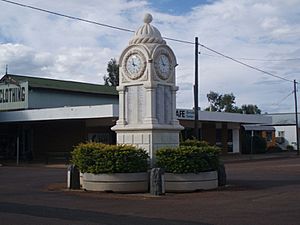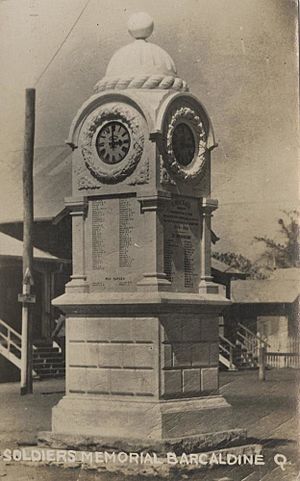Barcaldine War Memorial Clock facts for kids
Quick facts for kids Barcaldine War Memorial Clock |
|
|---|---|

Barcaldine War Memorial Clock, 2009
|
|
| Location | Ash Street, Barcaldine, Barcaldine Region, Queensland, Australia |
| Design period | 1919 - 1930s (interwar period) |
| Built | 1924 |
| Architect | Andrew Lang Petrie and Son |
| Official name: Barcaldine War Memorial Clock | |
| Type | state heritage (built) |
| Designated | 21 October 1992 |
| Reference no. | 600018 |
| Significant period | 1924- |
| Significant components | clock, memorial - clock tower, views to |
| Builders | Andrew Lang Petrie and Son |
| Lua error in Module:Location_map at line 420: attempt to index field 'wikibase' (a nil value). | |
The Barcaldine War Memorial Clock is a special monument in Barcaldine, Queensland, Australia. It was built in 1924 to remember the brave local men who served in the First World War. This beautiful clock tower stands proudly in the middle of Ash Street, reminding everyone of the sacrifices made.
It was designed and built by a company called Andrew Lang Petrie and Son. Today, it is listed on the Queensland Heritage Register because of its historical importance.
Remembering the Past: The Clock's Story
The Barcaldine War Memorial Clock was officially revealed on May 21, 1924. Sir Matthew Nathan, who was the Governor of Queensland at the time, did the honors. This impressive memorial was created by Andrew Lang Petrie and Son, a well-known company from Toowong, Brisbane. It cost about £524 to build.
Honoring World War I Soldiers
The clock tower is made of marble and granite. It honors 292 local men from the Barcaldine area who served in the First World War. Sadly, 38 of these men lost their lives. The memorial helps us remember their courage and sacrifice.
Barcaldine's Early Days
Barcaldine became a town around 1886. This happened when the Central Western Railway was extended to the area. In 1891, Barcaldine was the site of a very important event: the shearer's strike. This strike caused a lot of trouble but also led to the creation of the Australian Labour Party. Soon after, water from underground (artesian water) was found. This brought more people and new businesses to the town.
Why War Memorials Are Important
Before the First World War, Australia didn't have many public monuments. But after the war, memorials became very important. They were the first national monuments, showing how much the war affected the young country. Australia lost 60,000 people out of a population of about 4 million. This was a huge loss.
People started building memorials even before the war ended. These monuments were like sacred places, almost like graves for the Australian soldiers who were buried overseas. The word "cenotaph" means "empty tomb." It was used because many soldiers couldn't be brought home.
Australian war memorials are special because they honor everyone who served, not just those who died. Australians were proud that their army was made up entirely of volunteers. These memorials show how much communities were involved in the war effort.
Different Kinds of Memorials
War memorials also show the skills of local builders and artists. In Queensland, statues of a "digger (soldier)" (an Australian soldier) were very popular. In other states, tall, thin monuments called obelisks were more common.
Many First World War memorials have been updated to include later conflicts. Some have also been moved or repaired over time.
Choosing a Clock Memorial
While many types of war memorials were built in Queensland, very few were clock towers. The people of Barcaldine decided on a clock memorial after a public vote in 1922. The Barcaldine Shire Council first suggested the idea.
This clock tower is very decorative. The company that built it, A L Petrie and Son, called it "clock tower number two design." They were the biggest monument builders in Queensland at the time. The monument was damaged by a storm in 1992, and its clocks were replaced.
What the Clock Looks Like
The First World War Memorial stands in the middle of Ash and Beech Streets in Barcaldine. It's a very noticeable landmark in the town. It sits on a concrete base with rough stone posts at each corner.
Key Features of the Memorial
The memorial is about 12 feet (3.6 meters) tall. It has a base, a middle section called a pedestal, and the clock at the top.
The memorial is made of marble, likely from the Ulam Range. It sits on a stepped base of rough granite. Above this, there's a smooth marble step with a special inscription on the front. On top of this is a marble plinth (a block-like base) with a simple top edge.
The Names of Heroes
Above the plinth is the pedestal. This part has square plates of marble with columns at each corner. On these plates are the names of the 292 local men who served in the First World War. The names of the 38 fallen soldiers are on the front.
The Clock Tower
The clock sits above the pedestal. There is a clock face on all four sides. These faces light up at night. Each clock face is surrounded by a laurel wreath (a symbol of victory). There are also carved decorations in the bottom corners.
A curved shape over each clock face creates a dome-like surface. On top of this sits a large cable-shaped molding. This is crowned by a smaller dome with a marble sphere on top. The four clock faces are controlled by a master clock. This master clock has an electric pendulum and is located in the Barcaldine Shire Hall.
Why It's a Heritage Site
The Barcaldine War Memorial Clock was added to the Queensland Heritage Register on October 21, 1992. This means it's a very important historical place.
Showing Queensland's History
War memorials like this one show how Queensland's history has changed. They represent a time when people felt very strong Australian patriotism and nationalism, especially after the First World War. These monuments are a unique record of that time. They also show what people liked in terms of design between the wars.
A Unique Memorial
This memorial is special because it is one of the few clock-type war memorials in Queensland. It is also the only one of its specific design.
A Great Example of Commemoration
Built in 1924, the Barcaldine memorial is a great example of a structure built to remember a major historical event. Its design and materials help it serve as a lasting reminder.
Beautiful and Important
The clock tower is important because it looks beautiful and stands out in the street. It also shows very high-quality craftsmanship and design.
Strong Community Connection
The Barcaldine memorial has a strong and ongoing connection with the local community. It reminds them of the big impact of the war. It is also a central place for remembering those who served.
Connected to Important Builders
This memorial also has a special connection with the monumental masonry company A L Petrie and Son. It is a great example of their excellent work.


